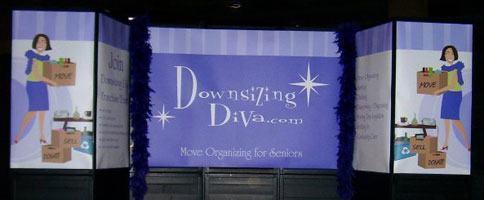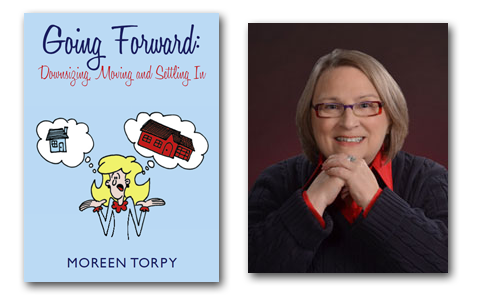Estate Organizing and Downsizing: The Initial Assessment
This page may contain links to Amazon.com or other sites from which I may receive commission on purchases you make after clicking on such links. Read my full Disclosure Policy

I met Linda Vanderkolk when I spoke about Blogging: Beyond the Basics at the 2011 POC Conference. Since then she’s become a regular contributor to the Professional Organizers Blog Carnival, recently attaining the status of Star Blogger. A specialist in downsizing and estates, I’ve invited her here to share some advice about working in this area.

Every year, thousands of older adults leave their larger homes for smaller, more manageable spaces. Some no longer want the burden of home ownership. For some, physical and health issues make caring for a home much too difficult.
It’s not just the individual that is downsizing that will find this process difficult. Family members will also find this a challenging time as they switch their gears and focus to take care of a loved one, needing to sort through items of financial value, important papers, items of sentimental value, and items of seemingly no value at all.
Enormous decisions are involved when these major life changes occur, and they can be extremely overwhelming without the assistance of a professional organizer who can provide experience, expertise, support and project management to help with all the details and major decisions required. When handled correctly, this type of project can be an extremely rewarding experience for both you as a professional organizer and your client(s). Preparation and effective and efficient project management in these cases is your key to success.
So what do you do when you are contacted by a potential client advising that his 85 year old father just passed away and mom is now alone in the family home, one in which she has been living for the past 40 years? She can no longer manage on her own and needs to be downsized and moved to a retirement residence, but there is a lifetime of memories in this home that needs to be sorted. What’s your first step?
The Initial Assessment
Without a thorough and detailed consultation and assessment process, the rest of your project will simply go down the tubes. Meeting with your client and his mother, on site at the family home, is critical. The information and detail you obtain at this stage of the process will be crucial to making this transition smooth. Don’t forget to take details on any health or medical issues you need to be aware of when working alongside your clients as well. It’s important to be aware of any neurological, muscular, or cardiovascular issues your clients may have in order to ensure their safety along the way. This background is helpful so you can determine how best to manage a client and their expectations on a project.
By the time you have been selected to work with your client, the client or the family will know to where your client is moving. Space will be the primary consideration in determining what can go and what cannot.
Important Questions
There are many questions to ask and much information to be learned during your initial consultation. For instance:
- What is the size of the new home compared to the current home? Determining what will fit into the new home will depend on this very important question. Obtain the size of the new rooms, especially the bedrooms and living room, to determine if existing furniture will fit into the new space. Bookcases are usually large and bulky with many items on them rarely used or referenced. Will there be enough room in the new home without feeling overcrowded?
- Is it a house or a condo? A retirement residence? If the client is moving into a condo, chances are that many tools, lawn and garden equipment will not be required.
- Does the client have any hobbies or interests? A second bedroom may have to double as a home office, sewing or hobby room so keep this in mind when planning for the layout of the new space.
- Does the client entertain on a regular basis? Keep this in mind when going through the kitchen as small appliances and extra bakeware may not be required. Kitchens are always a primary source of clutter and may be your biggest challenge if the kitchen in the new home is smaller (which it likely will be). If less entertaining will be done or will be minimal then perhaps only one set of dishes needs to be moved instead of the two or three commonly found in many homes.
- Do the appliances need to go? The sale of a home normally can include the inclusion of major appliances so the current appliances may not need to be moved.
- Are there storage facilities available? There may be times where the client just can’t give up some items and will require additional space for items that will not fit into the new home. Although not encouraged, there are instances where we need to accommodate for this.
Family Walk About
Once it has been determined what will definitely be moving to the new home, it is time to take a walk through the current home with the client and family members to determine what specific items are going to family members. These can then be recorded on paper or sticky tags with the name of the recipient affixed to each item.
Be prepared to manage family disputes over items that one or more family members are interested in.
This can be a wonderful time for family to reminisce and remember stories regarding the items, which in turn can emphasize to the client that it is okay to let go or pass along something for others to enjoy now.
Next week, we’ll look at ways to dispose of items not going to the new home in a way that honours your clients’ treasures.
Image © photography33 / depositphotos




Great list of questions! I have been organizing seniors for about 5 years now and it definitely is different that organizing parents or single individuals. Some of my suggestions would be to be prepared for lots of storytelling. The process also goes a lot slower than other organizing projects. So, patience is very important. Also, be flexible on the number of working hours each week. You may need to cut your time shorter since they may not be able to do as much organizing as you are used to doing in one session. I love to hear their life stories and how they have gotten to this point. Thanks for sharing.
Yes, I completely agree! I find the older the client the more stories they have and indeed we need to factor that time into our assessments. Very good points!
Excellent points! One thing that made me nervous with a specific client who is 85 is we were primarily working in the basement and we had to go up and down the stairs quite a bit. Plus she was very independent still getting up on step stools and such. Of course I wanted to say something but if she feels like she is still capable I let her but I also watch her more closely to see how tired she may be getting. It’s a fine balance between their independence and their safety sometimes. It’s just completely different than working with a younger person. People who want to work with seniors should account for this. 🙂
These are brilliant points, indeed! When working with seniors there are many things to take care of and all of them a crucial! Moving can be very traumatic for them so the people should be more than delicate! Thank you for the post! Greetings, Balham Removals Ltd.
I’m about to be part of a panel presentation on this topic, so great to read this post and the comments. It is a marathon, not a sprint, but hiring a professional can really ease the whole process tremendously!
Thank you and good luck on the panel!